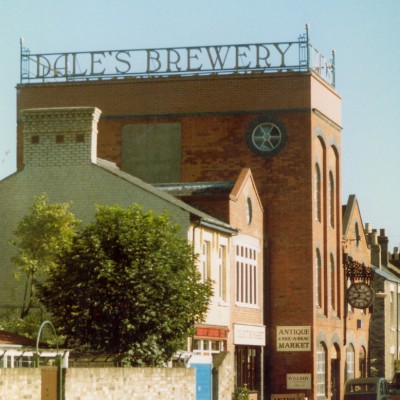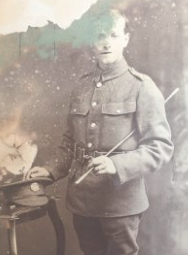Search by topic
- archaeology
- Building of Local Interest
- charity
- church
- crime
- dressmaker
- fire
- Great Eastern Railway
- Listed building
- Mapping Relief
- medieval
- oral history
- poverty
- Public House
- Rattee & Kett
- Religious House
- Roman
- scholar
- school
- Then and Now
- tudor
- women
- work
- world war one
- world war two
Search by text
The Great War in St John’s Parish: Cherry Hinton Road (north side)
World War One in Cherry Hinton Road
Cherry Hinton Road (North Side)
The houses are listed starting at the western (Hills Road end). Most houses are still to be found in 2015, those some listed on the town guide for 1913 at the far east of the road, where Mowbray Road is today, are very difficult to identify. In October 1914 the field at the junction of Cherry Hinton and Perne Roads was set up as the tented barracks for the Cambridge Regiment of the Suffolk Regiment. Despite local protests, in 1916 the site became a VD hospital for soldiers and at the end of the war there were 800 patients.
Honore (demolished): Edgar Lewis Anderson, b 1895, was the son of Lewis, a stained glass artist. He became a lance corporal in the Cambridge Regiment. While serving with a light trench mortar battery at St Julien, 31/7/1917, he was was awarded the DCM for conspicuous gallantry and devotion to duty. Though wounded in the assembly position for an attack, he carried the gun 4,000 yards to the final objective and dug in under very heavy fire. He was rapidly outflanked, and, all his team having been wounded, he remained behind and blew up his gun. He then fell back and joined the infantry using his rifle to help to repel the attack. He acted throughout the operation with great coolness and devotion to duty.
57 Avoncliff: William Thomas Cherry b 1884 was a clerk and teacher of shorthand in 1911. He became a sergeant in the Northampton Regiment. He served in Ismailia in Egypt and was severely reprimanded when absent on active service until seen by the military police in Bridgwater St 6.30 am on 14/6/1918.
59 Hillside: P G Pope was a private in the Cambridge then Northamptonshire Regiments. It was reported on 4/6/1915 that he had been wounded in the foot but not seriously.
59: Wilfred Lester Pope, b. 1900, volunteered for the Red Cross from 1916-1917 on hospital, convoy and air raid duty.
63 Home: Jack Layton, b 1897, became a lance coporal in the Cambridgeshire Regiment. He enlisted on 14/2/1915. He was awarded the DCM in the Spring of 1918 while serving in France.
His sister, Marjory Layton (1899-1970), volunteered for the Red Cross from 1917-1919. She worked as a kitchen orderly at Wordsworth Grove, Newnham. Her hours were 3+6 alternate weeks. They were the children of Frederick, a horse buyer, and Alice Layton.
Wordsworth Grove was the 1st Borough Red Cross Hospital where VAD detachment 28 worked. An extensive interview with Dr Joan Lush about duties at the hospital can be seen in this IWM film. Information about auxiliary hospitals in general can be found on the Red Cross website.
73 Glenthorne: James Aylett, b 1867, was a groom and coachman who by 1913 owned his own cab. He became a private in the Army Veterinary Corps. He served in Alexandria, Mustapha, Salonica and Malta and was eventually invalided with malaria.
77 (31): Stanley John Condor, b 1892, was a clerk who became a corporal in the 1/c MGCS Tank Corps. His father seems to have moved to 324 Cherry Road during war.
83: Bertram Colin (Calin) Brown, b 1899, was a railway clerk. He enlisted in 1917 and was assigned to the Army Service Corps.
87: Mrs Shadbolt volunteered for the Red Cross fro 1916-1918. This may be the same person as Annie Shadbolt, b. 1896, who in 1901 was living with the Gentle family.
95 Mon Abri: Arthur Ernest Coleman b 1880, was a servant at Clare College in 1911. On enlistment with the Royal Garrison Artillery he is described as a smallholder. He married Catherine at Gt Gransden in 1915. In August 1918 he was confined to barracks for 3 days as punishment for failing to salute an officer in Piccadilly.
99 Rock View: Edwin Horace Wilson b 1884, joined the London Regiment. He was discharged in 1916 with shrapnel wounds to head and neck and slight facial disfigurement and awarded a pension on the basis of 50% disablement.
119 Beauclare Terrace: Ethel Mary Richmond volunteered for the Red Cross in 1916 and worked as a nurse at Huntley VAD hospital.
123 Beauclare Terrace (10):
George Edward Porter, b 1895, was a private with 1st Bttn Cambridgeshire Regiment. He was killed on 14/10/1916 in France probably in the successful attack on the Schwaben Redoubt near Thiepval. He was buried in Mill Road cemetery Cambridge and his father was given a war gratuity of £9.
Arthur Ernest Bright, b 1896, was an apprentice ironmonger in 1911. He enlisted on 13/10/1914 and became a lance sergeant with the 1/1st Bttn Camb Reg.
137 Victoria Terrace (5): William Sizer, b 1875 was a driver who joined the RAMC and served at the East Leeds War Hospital.
139 Victoria Terrace (6): George Bowyer, b 1879, was living with his mother in 1911, his occupation whitesmith. He had served in South Africa during the Boer War with the 3rd Cambs. Volunteer Battalion and joined the Territorial Army in 1908. He took a machine gun course in 1911. He re-enlisted in 1913 and was promoted to sergeant in the 1st Bttn Cambridge Regiment. In June 1916 he was discharged from the Territorials to re-enlist in the Machine Gun Corps.
147 Roseneath:
William Henry Doe, b 1888, was a hide buyer living with his parents in 1911. In 1917 he had been refused exemption from military service because of business hardship. He later joined the Royal Flying Corps.
Frederick Thomas Doe b 1891 similarly applied for exemption in 1916 but was refused. The unit he joined is unknown.
157 Middleton Terrace (1): Ernest Smith served as a kitchen porter at the Royal Air Factory in Farnborough. He married Rosina Twinn of 157 Cherry Hinton Rd.
159 Middleton Terrace (2): Iris Cowell volunteered for the Red Cross from 1915-1918 at the First Eastern General Hospital.
163 Middleton Terrace (4): William Gilbert Radford, b 1894, was a house boy living in King’s College in 1911. He was reported wounded in 18/10/18 and in a hospital in Norwich.
165 Middleton Terrace (5): Arthur Frost, b 1881, was a Post Office mechanic who joined the Royal Engineers in 1918.
195 Bleak Cottages (1): Edmund Pierson, b 1895, son of Mr T E and Mrs Pierson of The Island Bungalow, Quy, was a florist’s errand boy in 1911. He served as a corporal in 1st Bttn Cambridgeshire Regiment and was killed on 4/9/1916, presumably in action on the Somme.
211 Palgrave Terrace (3): Andrew Joseph Linsey, b 1878, was a bricklayer and laundryman. He served with the 336th (HS) Works Company Labour Regiment.
215 Palgrave Terrace (5): Arthur Frederick William Peachey, b 1890 Babraham, was a chauffeur who signed up in 1915 and joined the Army Service Corps.
219 Maidstone Terrace (1):
Joseph Leonard, b 1885, enlisted in Cambridge in 1903 and served in India in 1905. In 1911 he was a servant at the Old Castle Hotel in Cambridge. He served in WWI as a private in the 2nd Bttn Suffolk Regiment. On 26/8/1914 he was reported missing at Batle of Le Cateau. He rejoined his battalion and in March 1915 contracted influenza. In June 1915 he was discharged unfit and then married Anne Stearn, laundry maid of 219 Cherry Hinton Road on 5/6/1915 at St John’s.
His brother, Alfred Leonard, b 1895, in 1911 a farm labourer, joined the Pioneer Royal Engineers.
Another brother, Wilfred Leonard, b 1893, in 1911 a cowman, joined the 1st Bttn Suffolk Regiment. Reported to be a prisoner of war 28/1/1916.
231 Maidstone Terrace: Sydney Thomas Drake, b 1884, a fruiterer. He joined the 13th Queen’s Inf. Labour Coy and then the Royal Defence Corps.
249 Rhianva Terrace (6): Percy John Gobey Sapper, b 1880, in 1911 he was a bricklayer. When mobilized in 1917 he joined the Pioneer Battn Manchester Regiment and then the Royal Engineers as a sapper and service in Italy.
Herbert A Mildon Corporal CMP (Corps of Military Police) married Eleanor Swann, waitress, of 190 Cherry Hinton Road in June 1917.
251 Rhianva Terrace (7): Ernest William Harris, b 1882, a wash house laundryman. He became a gunner with the 99th Siege Btty Royal Garrison Artillery. He married Charlotte in 1906 and they had 4 children. In July 1918 he was dangerously ill in hospital (see letter from wife on record.) after being gassed on 29/6/1918. By 15/7/1918 he was no longer seriously ill and on 20/7/1918 he was sent to Huddersfield War Hospital.
253 Rhianva Terrace (8): Harry Precious was a private in the Suffolk Regiment. He was reported killed in action 23/4/1917 but then on 15/6/1917 reported to be a prisoner in Germany. Before the war he worked in the kitchen at Queen’s College.
The Paddocks: Arthur James Precious enlisted in the Suffolk Regiment 12/8/1914 but discharged no longer fit on 5/7/1916. His file states that he ‘has never been fit. A debilitated nervous subject.’ He served in France 1915.
unknown address in Cherry Hinton Road: Albert Ernest Hardingham was born in 1895 at Wisbech. In 1911 he was grocer’s clerk in Sawbridgeworth. As a corporal in the Essex Regiment he was awarded the Military Medal.
Contribute
Do you have any information about the people or places in this article? If so, then please let us know using the Contact page or by emailing capturingcambridge@
License
This work is licensed under CC BY-NC-SA 4.0












